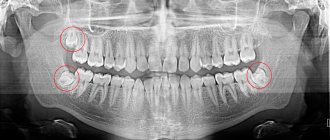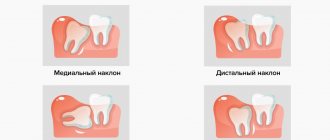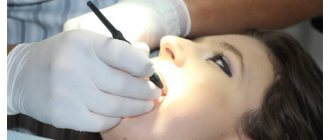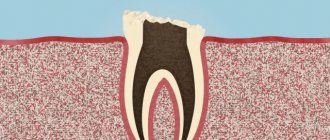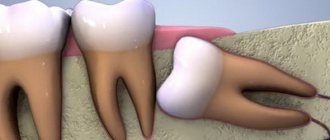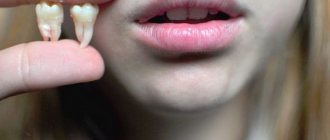Judging by the name, wisdom teeth are supposed to add intelligence to us, but in reality they bring nothing but problems. Why are they even needed? And what to do with these late teeth? Dentist, candidate of medical sciences, head of the expert dentistry center Studio32 Dmitry Vladimirovich Smirnov will dispel the main myths about wisdom teeth and tell you how and when they need to be treated or whether it is better to remove them without regret.
Wisdom teeth received this name because they erupt at the age of 15 - 25 years, when it is believed that a person should already be more or less intelligent. These eighth teeth on the jaw, or third molars, are now considered vestigial because they have lost their original meaning. In the process of human development, our food became more and more soft, as people learned, for example, to heat treat tough meat or grind coarse grains into flour and bake bread from it. Evolutionarily, our jaw has become smaller and smaller and now can no longer accommodate four, essentially, extra teeth. This is where the main difficulties associated with wisdom teeth arise. Most people have them genetically, but there is simply no room for them on the jaw to function normally. There are, of course, lucky people who do not even have the rudiments of wisdom teeth. But 9 out of 10 people still have wisdom teeth, either as unerupted teeth, or erupt in any number from 1 to 4. And in the vast majority of these teeth there are potential problems.
Features of caries on figure eight
The cause of this disease is the accumulation of bacterial plaque and poor hygiene. “Eights” erupt late, on average after 18 - 20 years, and sometimes remain partially unerupted (impacted). At the same time, wisdom teeth are located far in the oral cavity, and it is almost impossible to clean them properly. If part of the crown is located under the gum, a so-called gum hood is formed, where food particles easily fall, and the tooth is destroyed even faster. These factors are the main reasons for the appearance of caries on the figure eight.
Functions
Opinions differ as to why our contemporaries need eighth teeth. Some experts believe that since the “eights” were created by nature and still appear, then they should not be removed unless absolutely necessary. In addition, sometimes the third molar becomes a real lifesaver for fixing a denture. Other doctors are sure that it is better to immediately remove wisdom teeth if they cause concern. After all, these rudimentary organs no longer fulfill their main role - people have long switched to soft foods that have undergone heat treatment.
Symptoms of wisdom tooth caries
The main danger of the disease is that it is asymptomatic for a long time. And if the patient ignores regular preventive examinations at the dentist, he will learn about the problem at a deeper stage. For example, cervical caries of a wisdom tooth is often discovered only when the patient begins to suffer from sudden pain.
At first, a dark spot appears on the enamel, but it is difficult to see, because the tooth is located far away and at an angle. There is no pain because the enamel is devoid of nerve endings.
As the disease progresses, it continues to destroy the enamel and reaches the dentin. Here the first symptoms begin to appear - bad breath, and sometimes short-term pain under the influence of mechanical, temperature and chemical stimuli. You need to remember: if your wisdom tooth hurts, caries is most likely the cause.
Dentin is a porous tissue, so at the middle stage the disease begins to progress very quickly: demineralization of the tooth occurs and necrotic changes begin. Deep caries of a wisdom tooth is characterized by damage to hard tissues, which is why the tooth reacts strongly to hot and cold, sour and sweet. A prolonged aching pain occurs, the coronal part is severely destroyed.
Structure
Externally, the “eight” is no different from other permanent molars; its uniqueness lies in the following:
- In most cases, teething occurs between the ages of 16 and 25;
- At the moment when the third molar finally appears, the remaining teeth have already taken their places on the jaw, leaving practically no free space. Accordingly, the eighth tooth has to push away its neighbors, which is not always possible;
- Wisdom teeth are extremely difficult to treat because dentists cannot always reach them. And most often, if problems arise with the “eights”, they are simply removed.
Wisdom tooth caries - treat or remove?
It is important to remember that the carious process cannot be left to chance even at the initial stage: the infection spreads quickly, and even healthy organs of the oral cavity can soon be affected. It's time to answer the question that torments many: if wisdom tooth caries is detected, what to do - therapy or removal?
Removal of a wisdom tooth with caries is indicated
- A wisdom tooth is a rudiment that is practically not used in the chewing process, and there is little benefit from it.
- Eights are located far away, access to them is limited, which makes it very difficult to provide quality treatment. This increases the likelihood of re-infection.
- The therapy is tiring for the patient because he has to sit with his mouth wide open throughout the entire procedure. This is especially true for the treatment of caries of the upper wisdom tooth.
As a rule, removal is indicated in cases where the tooth is dystopic and/or impacted, constantly injures the cheeks and tongue, and causes inflammatory processes due to difficult eruption. Whether to remove a wisdom tooth with caries, if it grows normally and does not cause any problems, should be decided individually together with a specialist.
Speculation and truth about preserving wisdom teeth
Speculation No. 1. Some people believe that nature has nothing superfluous, which means that third molars are useful for something. But it has already been scientifically proven that our chewing system can cope quite well without these teeth. Now the norm for a person is 28 teeth, not 32.
Speculation No. 2. Sometimes they want to preserve wisdom teeth at all costs in order to use the “eight” in a bridge structure in the future if one of the chewing teeth fails or collapses. But this is a misconception. Firstly, because the “eights”, as a rule, occupy the wrong place, which makes it impossible to install a bridge. Secondly, modern dentistry is trying to get away as much as possible from bridge-like or combined structures in favor of single ones. Today, implantation is the highest quality and modern method of replacing missing teeth.
It is fair to note that a number of scientific and practical works are being carried out in the world, as well as in our clinic, related to the transplantation of eighth teeth in place of lost, damaged sixth or seventh teeth. But at present, such operations are exclusively scientific and research in nature. This technique has maximum observation results of less than 10 years - for dentistry this is still the minimum period of time to be able to talk about some kind of statistics or system. In addition, transplanting such teeth has a lot of restrictions: only an erupted tooth is transplanted, healthy in all respects, without caries, the bone tissue at the transplant site should not be damaged, and so on... This is far from a mass procedure, which is performed only by leading surgeons, very a small number of patients. If you wish to use a wisdom tooth for transplantation, a patient at our clinic must undergo a specialized consultation, following which a council of specialists will decide on the possibility of this type of treatment.
World dentistry has clearly formulated its attitude towards preserving wisdom teeth - they can be preserved only under the following conditions:
— there is enough space on the jaw for their teething;
— having erupted, these teeth did not disturb a person’s bite;
— there are normal conditions for maintaining good hygiene of these teeth.
If a carious process has begun on these teeth, or they in any way interfere with other teeth or the chewing process in general, then this is an absolute indication for their removal. The only reasonable and correct way to treat wisdom teeth is to remove them. World dentistry in this matter is merciless to the “eights” and allows their presence exactly until the moment they do not harm anything. It is difficult to independently assess the destructive ability of third molars, since a person is very adaptive. Only a specialist can identify the disturbances that wisdom teeth introduce into the functioning of the dental system.
Speculation No. 3. Sometimes people think that if wisdom teeth have not erupted, then there is absolutely no need to worry about them. However, unerupted teeth are a kind of cocked spring that is located inside a person’s jaw, and if any unfavorable factor begins to act on this spring, it will make itself felt. Hidden “eights” can provoke all kinds of inflammation of the gums, cause caries, and cause pain. Of course, not all wisdom teeth that remain undetected are dangerous, but in any case they need to be monitored. A person who has not acquired wisdom teeth (one, two, three or all four) often cannot independently understand whether he has them, or whether he is lucky - and they are not even in the rudiments. To determine this, you need to undergo an X-ray examination, at least take a general panoramic image (OPTG), or undergo a modern cone-beam computed tomography (CBCT). Ideally, such images should be taken for diagnostic purposes once every 2-3 years for each person in order to exclude hidden processes and assess the general condition of the jaw. Modern X-ray examinations have ultra-low radiation, so such examinations are as safe as possible.
The eighth teeth are removed if necessary, starting at the age of 12-14 years. This is usually associated with orthodontic treatment. Before orthodontic treatment at any age, two things are mandatory: thorough oral hygiene and removal of wisdom teeth, erupted or unerupted.
Treatment of wisdom tooth caries
Despite the irrationality of preserving the eight tooth, sometimes the doctor recommends abandoning extreme measures and prescribes treatment for the eighth tooth.
Indications for removal of a wisdom tooth with caries
- Caries is at an early stage: the tooth can be saved, and treatment will not be difficult or expensive.
- The figure eight is involved in prosthetics - for example, it is a support for a bridge or clasp prosthesis.
- The tooth erupts normally, without deviations.
- There is an antagonist that will ensure uniform distribution of the chewing load.
- Removing a wisdom tooth with caries is contraindicated due to pregnancy or other reasons, but it is necessary to stop the spread of infection.
Therapy proceeds as follows:
- the affected tissue is removed with a drill;
- the resulting cavity is disinfected with antiseptic agents, an insulating gasket is placed on the bottom;
- the cavity is filled layer by layer with a composite material, which hardens under the influence of a photopolymer lamp;
- The shape of the tooth is adjusted using a drill so that it looks natural and ensures complete closure with the antagonist tooth.
So if you are wondering whether wisdom teeth cure tooth decay, then the answer is yes. However, it is important to consult a specialist in time and not to advance the disease.
How does the removal work?
If there are indications for the removal of wisdom teeth with caries, the procedure is performed exclusively by a dental surgeon. Depending on the condition of the tooth and the characteristics of its development, simple or complex extraction can be performed.
Simple removal involves the usual manipulation of tooth extraction using forceps. But such a procedure is only possible if the only pathology is caries.
Most often, third molars require complex removal, which involves dental surgery and surgery. Complex removal is necessary for pathology of the root system, destruction of more than 50% of the tooth surface, dystopia or retention. During the procedure, the dentist may resort to cutting soft tissue, breaking the tooth and removing it in parts and other manipulations.
After removal of wisdom teeth with caries, an x-ray diagnosis is required to exclude remnants of parts of the tooth or root. After this, stitches are applied.
Deep caries of wisdom tooth
If the development of the carious process is not stopped in time, the infection will gradually penetrate deeper and eventually reach the pulp. Inflammation in the pulp tissue is called pulpitis and is accompanied by aching pain that is difficult to ignore. It is not easy to treat deep caries of wisdom teeth, since it is necessary to fill the root canals, and the roots of figure eights are usually curved. Untreated pulpitis can develop into more serious diseases - wisdom tooth cyst or periodontitis, which are much more difficult to combat.
Features of treatment
If the third molars are correctly positioned and the patient visits the clinic in a timely manner, wisdom teeth can be treated – therapeutically or medicinally.
If the doctor decides to remove the nerve, he may prescribe antibiotic treatment to stop the development of the inflammatory process. In case of painful sensations, analgesics will not help to cope with the cause of the disease; they are used only to wait for an appointment with the dentist without pain or to eliminate it after filling the canals. The main thing is not to put off visiting the clinic.
Stages of hole formation
The most common occurrence is the formation of a hole in a wisdom tooth. Inaccessible to cleaning with a regular brush, they become a convenient place for bacteria to accumulate. However, depressions in the enamel do not appear immediately; the last stages of caries development can be prevented if you constantly monitor the condition of your teeth. Let us briefly describe each of the progressive stages of caries development:
Initial stage: there is slight darkening on the tooth. To treat caries, it is enough to treat the affected area with a special solution, prescribe a diet, medicinal powders and toothpaste.
Superficial caries: there is slight destruction of the enamel without severe signs of pain. Slight roughness may be observed, and tooth sensitivity to cold and hot increases.
Middle stage: this is where the formation of depressions is diagnosed; not only the enamel is damaged, but also the dentin. Difficulties in brushing teeth and discomfort when eating sour, sweet or salty foods are noted. In this case, it is difficult to relieve pain even when taking analgesics.
Deep caries: the affected tooth cavity increases in size, the enamel is damaged over almost the entire area of the tooth, the dentin becomes softened. It is almost impossible to touch the tooth; there is complete damage to the neurovascular tissue.
Should resorcinated teeth be removed?
Patients of Soviet dentistries are aware of what resorcinol fillings are. Beginning in 1912 and for almost 100 years, caries was resorcinolized - eliminated using the resorcinol-formalin filling method. At the same time, the dentists did not inform the patients that subsequently the teeth turn yellow, decay, become increasingly fragile, and cannot be refilled.
Times have changed, and seemingly harmful fillings can be replaced with modern filling compounds. However, this turned out to be practically impossible - it is impossible to clean the channels from the resorcinol-formalin mixture. During the hardening process, the filling acquires the density of glass and is soldered to the walls of the root canal. The verdict of most doctors when dealing with resorcinated teeth is the same - removal.
But there is no need to rush in this case either. Today, modern dental equipment allows you to drill out and remove even the strongest glassy material and bring the tooth into excellent condition. Yes, not all clinics have the necessary equipment, but it is there. And finding “your” doctor after several consultations will completely solve this problem.
Features of growth
Wisdom teeth are considered rudiments - organs that have lost their basic meaning. Previously, they were needed to chew tough foods. In the process of evolution, food became softer and softer, so the need for them gradually disappeared. Over time, the size of the jaw has also changed - it has become smaller, and now cannot accommodate four extra teeth.
Typically, wisdom teeth appear between the ages of 18 and 27. It has been proven that “eights” do not affect the chewing process in any way - a person can easily do without them. Some people don't have them at all, and that's normal.
How to relieve pain when wisdom teeth erupt
This question must be of interest to every person for whom the growth of wisdom teeth causes at least the slightest discomfort.
Dentists recommend rinsing your mouth with antiseptic solutions to relieve pain when wisdom teeth erupt. The following solution is very effective. Dissolve a spoonful of salt, a spoonful of soda and two or three drops of iodine in a glass of hot water. Then you need to wait a little until the water temperature drops to the optimal and safe level, so as not to damage the gums and mucous membrane of the mouth, and then rinse the oral cavity with the composition. In order to relieve pain when wisdom teeth erupt, you can also use analgesics.
It should be understood that the methods listed can only provide temporary relief in the event of severe toothache. To get rid of emerging and potential problems during teething and to treat wisdom teeth, you must consult a doctor.
What to do if there is a hole in your tooth?
If you notice the development of at least the first stage, immediately go to a visit to the dentist. The hole is the last stage of carious damage, which can be very difficult to get rid of. Professional treatment of holes is carried out only in a dental clinic. The standard work plan of a specialist usually includes:
- Treatment of the oral cavity (plaque and tartar on the diseased tooth are removed, normal hygiene procedures are carried out).
- Anesthesia of the hole site (if the disease is of significant complexity).
- Removal of areas of dental tissue affected by caries, treating them with an antiseptic drug.
- Drilling the required shape to install a filling in it; if necessary, a therapeutic pad is applied to provide an anti-inflammatory effect on the nerve.
- Sealing the treated cavity with filling material, the color of which fully matches the color of the tooth. After this, the filling is adjusted according to the bite, ground and polished.
What causes a black hole to form in a tooth?
The main reason for the formation of holes in teeth, as already mentioned, is caries. Being a consequence of the activity of bacteria and microorganisms, it can lead to complete destruction of the tooth. Doctors note that there are many reasons for its appearance.
Important! According to statistics, women suffer from caries more often than men. This is associated with hormonal changes in the body that occur in women during pregnancy and lactation. In addition, people with malocclusions are more likely to develop cavities and holes in their teeth. Too narrow spaces between teeth, thinned enamel - all this contributes to the accumulation of food and the creation of a favorable environment for the development of microorganisms.
Can third molars be treated?
Wisdom teeth, like any other teeth, can be treated. But only if they erupt correctly, do not threaten the health and position of the rest of the dentition, and there is confidence that the treatment will be successful. If the specified conditions are met, it makes sense to preserve the “eight” for the following indications:
- If the sixth and seventh teeth are sick or severely damaged and must be removed, in this case the wisdom tooth is left as “the best of the worst” in order to provide the patient with at least some conditions for chewing, and the doctor - the basis for future prosthetics.
- If the six and seven have already been removed and it is necessary to preserve the abutment tooth for installation of prosthetic structures.
- In the presence of an antagonist tooth, completely healthy and subject to preservation.
In case of curved roots that complicate endodontic intervention, severe tissue destruction, dystopia or retention, no competent dentist will undertake to treat the “eights” - he will definitely recommend removal.
Indications for removal
In some circumstances, removing the “eight” becomes the only way out. In particular, the doctor will decide to get rid of the eighth tooth if:
- It is located at an angle and when cutting through it puts pressure on the roots of its neighbors;
- A partially erupted tooth injures the gums;
- When affected by caries, the treatment area is difficult to reach;
- The roots of the "eight" grow in the maxillary sinus;
- The patient suffers from facial neuralgia;
- Complications developed;
- There is a gum cyst in the eruption area.

